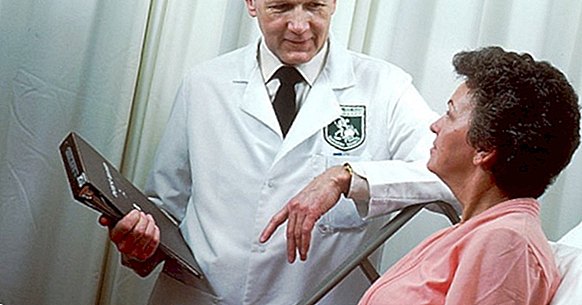The 4 types of forecasts and health status: some clinical terms
Possibly in some occasion we have heard in some informative or read in some news that certain person is admitted to the hospital for a serious injury, that is critical or that the prognosis is favorable or uncertain.
It is also possible that this type of terms comes to us because either we ourselves or someone we love has been admitted for some reason. These concepts refer to the health status and the expectation or prognosis that you have about someone suffering from some type of disease , accident or medical affectation. And the truth is that although usually when we speak of a serious illness, mild or of a reserved prognosis we can get a rough idea of what it implies, we do not always have a full knowledge of what we are trying to say.
Knowing this type of terms can be relevant in our day to day and that is why, in a generic way, throughout this article we intend to collect a series of concepts related to the different types of medical conditions and forecasts that sometimes we are communicated.
- Related article: "The differences between syndrome, disorder and disease"
Types of prognosis and severity of a disease
The health status of a person refers to the medical or health conditions that the person sustains, which may favor, maintain or harm in different ways their expectations of survival, life expectancy and ability to achieve or maintain welfare.
When we talk about health status We refer to a set of elements of a fundamentally biological nature, although psychological factors can also come into play. Although other aspects such as the psychosocial sphere also influence and can be symptomatic and even determinant for the health status of a person, in principle they would not fall within that concept.
Before the appearance of a disease, injury or medical alteration, the state of health of the subject in question will be compromised and be harmed. The presence of this disease supposes an alteration that can be categorized in different degrees depending on its severity. Below are indicated some of the main medical terms that refer to how a person is in relation to the severity of a specific condition
1. Mild disease or mild injury
We use the term mild condition in order to refer to a state in which the affectation, illness or injury suffered by the patient in question does not have any serious signs and an early recovery is expected without sequels. Approximately the recovery is usually calculated in about fifteen days. The prognosis is good .
An example is found in minor illnesses such as a cold or nailing an object in some uncommitted area, such as skin.
2. Less serious state
Classifying a disorder, disease or medical situation as a "less severe" prognosis implies that although a rapid recovery is not expected, it is not expected to pose a risk to the patient's life . The recovery can take between a fortnight or a month.
3. Illness or serious injury
The fact that a disease or alteration is serious supposes that said alteration implies an obvious danger to the life or functionality of the patient . The risk of death is present, or the injury may involve the loss or diminution of some relevant ability or ability of the person (for example, the ability to walk). The recovery usually takes more than a month.
Someone in serious condition could be a patient with pneumonia.
4. State, illness or very serious injury
A very serious state makes reference to the fact that the existence of a certain problem, affectation, injury or illness has a high level of probability of death. An example of this is when a patient has multiple internal injuries but is stabilized and the possibility of being saved is still considered.
- Maybe you're interested: "The role of Psychology in irreversible processes: 5 attitudes to death"
5. Critical state
Another term referring to the status / prognosis of a patient is that of critical state. In this case, this concept is used to indicate that the vital signs of the person in question are unstable, there being immediate risk to their life despite the possibility of recovery.
The subject is at a crucial moment and of extreme danger , the death being highly probable although depending on his response to the treatment he could recover. Generally the patient would be in the Intensive Care Unit or ICU, being highly monitored.
An example of a critical state could be found in hospitalized patients who suffer a cardiovascular accident or a heart attack, in the first moments. The person would be at risk of death but depending on the treatment could present an improvement and even save.
6. Acute state
The fact that a disease is in an acute state the presence of a clear and defined symptomatology that occurs in a limited period of time and generally short (never being more than six months). Being in an acute phase of a disease does not mean that it is more or less serious, implying rather than the evolution of this is fast in time (The conclusion of the illness may be complete recovery or death of the patient).
7. Chronic disease
That a disease or injury is chronic implies that said disease or disorder will be present during the rest of the subject's life from its diagnosis, said alteration being of long duration. In general, all those diseases that last for more than six months are considered as such. Many of them could be deadly if there were no medical means for its control.
Some examples of chronic diseases are the disorder of genetic origin, diabetes or HIV at present (being controlled by medication).
8. Condition or terminal illness
We are facing a terminal problem when the condition or injury presented by the patient implies his death in a relatively short period , generally of around six months (although it can be prolonged), and it is expected that this alteration is the cause of his death. The best-known example is that of cancer with metastases in its later stages.
The medical prognosis
As we have seen previously, there are multiple categories that allow us to determine the repercussions that have or can have the disease of different diseases. This state would refer to the current moment, but it is the basis that allows us to try to predict how the health of the person or patient in question will evolve.
This prediction regarding the most likely evolutionary course that an illness or injury can follow and the possibilities of overcoming is what is known as prognosis. This forecast is derived from the set of available data on the current status of the patient, his background, his environment and the illness or injury in question that suffers.
Types of forecast
As with the state of a disease, we can find different types of prognosis. The prognosis in itself does not have to be related to the disorder that the subject presents (although this influences), if not with the expectation that is had in each specific case. A) Yes, For example, two patients with the same type of cancer may have different prognoses .
1. Favorable or good forecast
The presence of a favorable or good prognosis is considered in those cases in which existing evidence suggests that the course of the disease that the patient suffers leads to recovery.
2. Moderate or intermediate forecast
This type of forecast indicates that the expectation regarding the health status of the patient is not extremely positive but that there are no data that make think about the possibility of death in the immediate future . It may, however, imply the presence of functional limitations or even some type of disability.
3. Severe prognosis, or poor prognosis
When we talk about a serious prognosis, we are referring, as its own name indicates, to the conditions of a certain patient suggesting that it exists a severe risk for his death or for the existence of severe limitations in his life .
- Maybe you're interested: "The duel: facing the loss of a loved one"
4. Reserved forecast
The term reserved prognosis is used to refer to a situation in which the doctors and professionals in charge of a patient are unable to determine the possible evolution or expectation regarding the outcome of the patient's condition . Typical of times when there is not enough information to be able to speculate about the patient's future or when there is a risk of complications.
An example of this could be found in the prognosis that would have a patient who has suffered a traffic accident and is unconscious and with a traumatic brain injury, but of which the degree of involvement is not yet known.



















